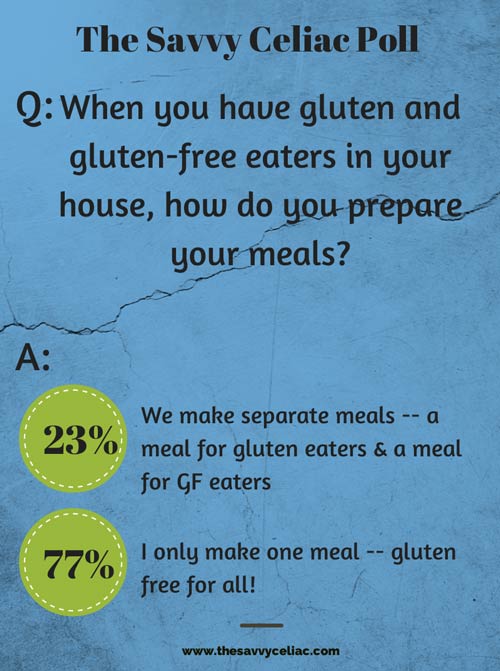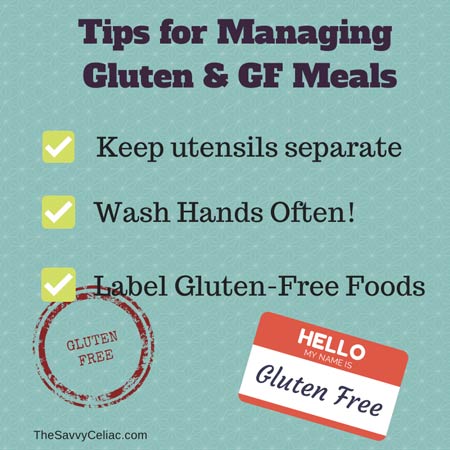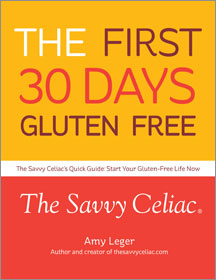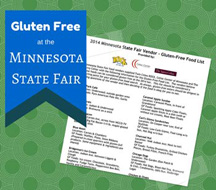“Doesn’t cooking separate gluten and gluten free meals drive you crazy?”
April 30, 2014 by Amy Leger | G+ Amy LegerRecently I was teaching a Gluten Free 101 class in the area and I was talking about cooking and changing your kitchen to be gluten free, when I was asked “Doesn’t cooking separate gluten and gluten free meals drive you crazy?”
Good question! I wondered, am I the only one doing this? I put a poll on The Savvy Celiac Facebook page to find out.
The unscientific poll found only about a quarter of the people making gluten free meals also create a separate meal containing gluten. The poll graphic pictured to the right tells the story. 23% do separate meals while 77% make one meal for everyone.
Ever since Emma’s celiac diagnosis (and subsequent gluten-free diet) in 2000, we have done separate meals. Now don’t get me wrong, when I make chow mein, I make it for everyone. But we have regular crunchy chow mein noodles and Emma uses Glutino Pretzels for her chow mein noodles.
If we had a pizza night, we probably would order out for the majority of the family and we’d make one for Emma at home (the pizza places near my house have not mastered the art of separate ingredients for gf pizza yet). Spaghetti night involves two pots of noodles (one gluten free) and two colanders, but one sauce and one pan of meat. But on burger night, we have burgers and fries and none of us use buns. So that night is 100% gluten free. So while I do make separate meals, it doesn’t happen all the time.
Does making separate gluten and gluten free meals drive me crazy?
No, not really. We have a rhythm down at this point.
- We plop our food on our plates so as not to contaminate the serving utensil.
- If I am worried about some kind of cross contamination like, for example, bacon during a pancake breakfast, I will serve the bacon first on each plate and set it aside, then people can grab their pancakes.
- Everyone washes hands before the meal
For us, this rhythm gets disrupted when we have guests. I am actually more apt to have a 100% gluten free meal when guests are here because then there is no chance for cross contamination.
Why do combo meals?
So why do we do separate meals sometimes? In our home, some family members prefer non-gluten-free items (like spaghetti). Also it is more budget friendly. Only having to buy gluten free flour, cookies, bread and noodles for one person is less expensive than for four.
But of course there is a risk to it. You have to be on your toes at all times regarding cross contamination:
- Don’t share utensils between gluteny and gluten-free foods
- Wash your hands with soap and hot water when moving from gluteny to gluten-free foods.
- Identify the products that are gluten free, in your cupboard and even in your refrigerator. In your fridge you will likely have two butters, jams, jars of mayonnaise, peanut butter, etc. One is a gluten free container and one not. Bethanny commented on Facebook “All jars in fridge that are GF have ‘GF’ written on top with sharpie…” and Stephanie (who also has a dairy issue in the family) has a smiley face system, “Anything with gluten or milk has a frown, anything that is good for [my daughter] to eat has a smiley face.”
There definitely is A LOT to think about when cooking a combo meal.
Why make gluten-free-only meals?
There is a reason 77% of those polled said they only made one gluten-free meal, it is simply easier, safer and less work.
The grocery budget will be higher, but there are ways to reduce that cost. Gluten Free on a Shoestring‘s first book (125 Recipes for Eating Well on the Cheap) is great at giving you recipes for baked goods and comparing the cost of when buy it at the store vs. making it. Eating in-season produce helps as well.
Some folks have gone from trying a combo house to moving all gluten-free because the combo thing just didn’t work.
Do what is best for your family and that may mean doing whatever DOESN’T drive you crazy! Do you have other tips? Feel free to share them in the comment section below.
Tags: celiac, cooking, gluten, gluten-free, kitchen, meals, separate




June 14th, 2014 at 5:22 pm
Although I live alone, I expect some of my gluten-free cooking methods could be helpful for families, too. First, I always mix Gluten-Free Bisquick with Pamela’s Gluten-Free Baking mix to enjoy a much better flavor, browning, and texture than either one gives alone.
I use a Kitchen Selectives electric pancake maker for a lot of things (little gluten-free pies and pasties, making home-made chicken nuggets, making a pancake in one slot and an egg in the other, etc), and instead of buying gluten-free bread which is pretty much good for nothing but toast and which aquires mold way too fast, I make a waffle at mealtime to use as bread, or for toast as with creamed peas on toast … or top a gluten-free Belgian waffle with fruit and whipped cream. For most things (other than cakes)I use nothing but the baking mix, a little oil, and water … no egg, no milk. Soft waffles (thicker batter) for sandwiches, crispy waffles (thin batter baked longer) for snacks (sprinkled with a wee bit of salt, maybe some oregano or celery flakes or some such, or sprinkled with cinnamon sugar for a delight with coffee). And 1/2 of a crispy waffle topped with cheese and covered with another 1/2 crispy waffle … then left on the waffle iron for a minute or so … makes the best toasted cheese sandwich ever. Add some ham lunch meat before melting the cheese, or make it an open-faced sandwich with additional toppings, and oh my.
If I want a baked open-faced pie, I don’t make a pie crust … instead, I spray a pie pan (regular size or a little foil tin) with cooking oil and dust it liberally with gluten-free baking mix to get an instant pie crust. Is it the same as regular? No, but there’s almost no work involved, it holds together well enough to work as finger food, and tastes fine. And for a “graham crust” for something like cheesecake, I cut shortening or oil into the baking mix, then mix cinnamon and sugar in (proportioned to taste and color), and quickly press the mixture into the pie pan. Sometimes I bake before pouring in the cheesecake batter, but for other recipes, I’ll pour the cheesecake or other pie filling in before baking. Either way, I find it right tasty. And again, the “mock graham crust” holds together quite well.
These tricks can cut down your kitchen time, and make it easier to produce special things for the individual who is gluten-free.